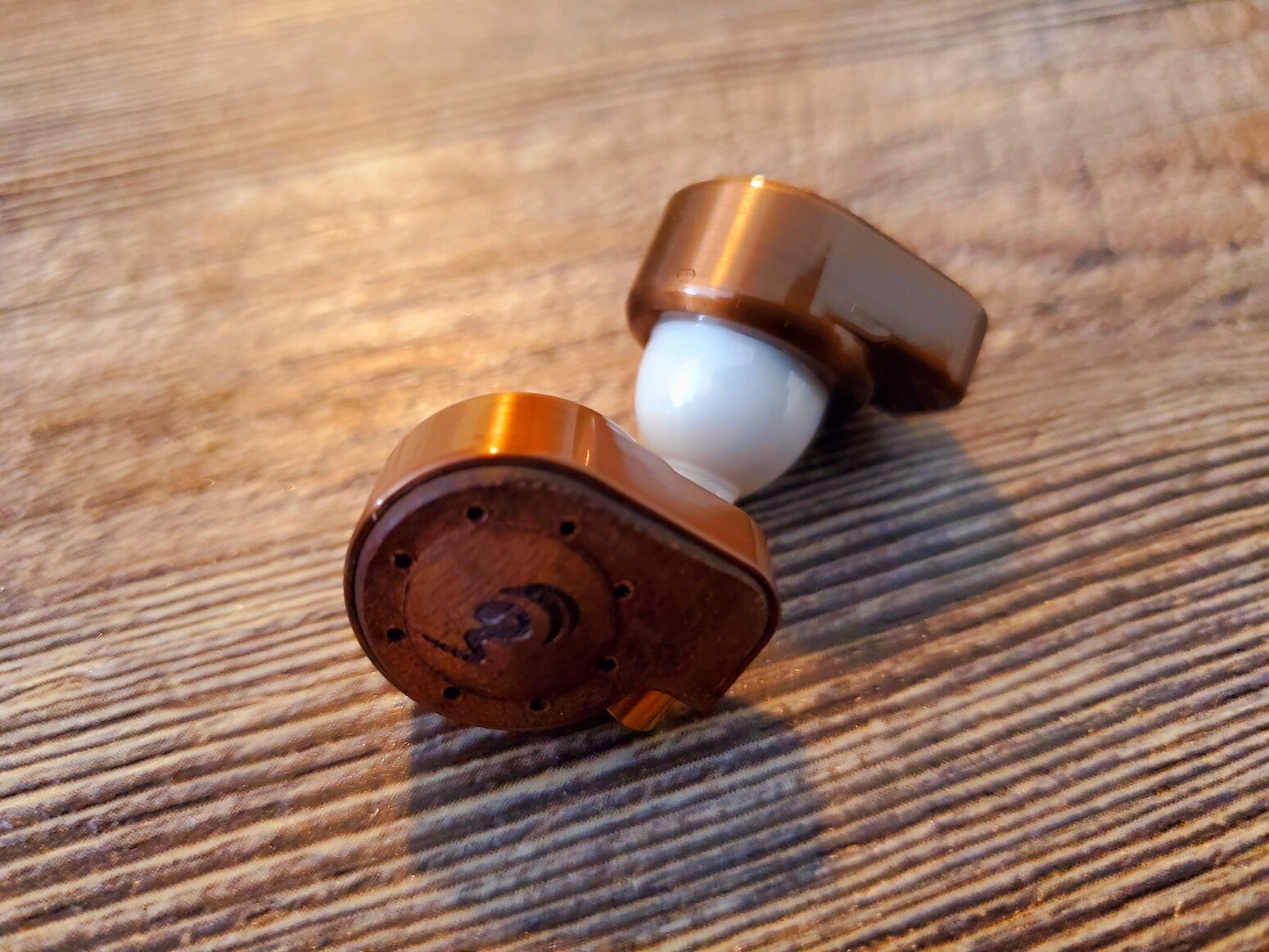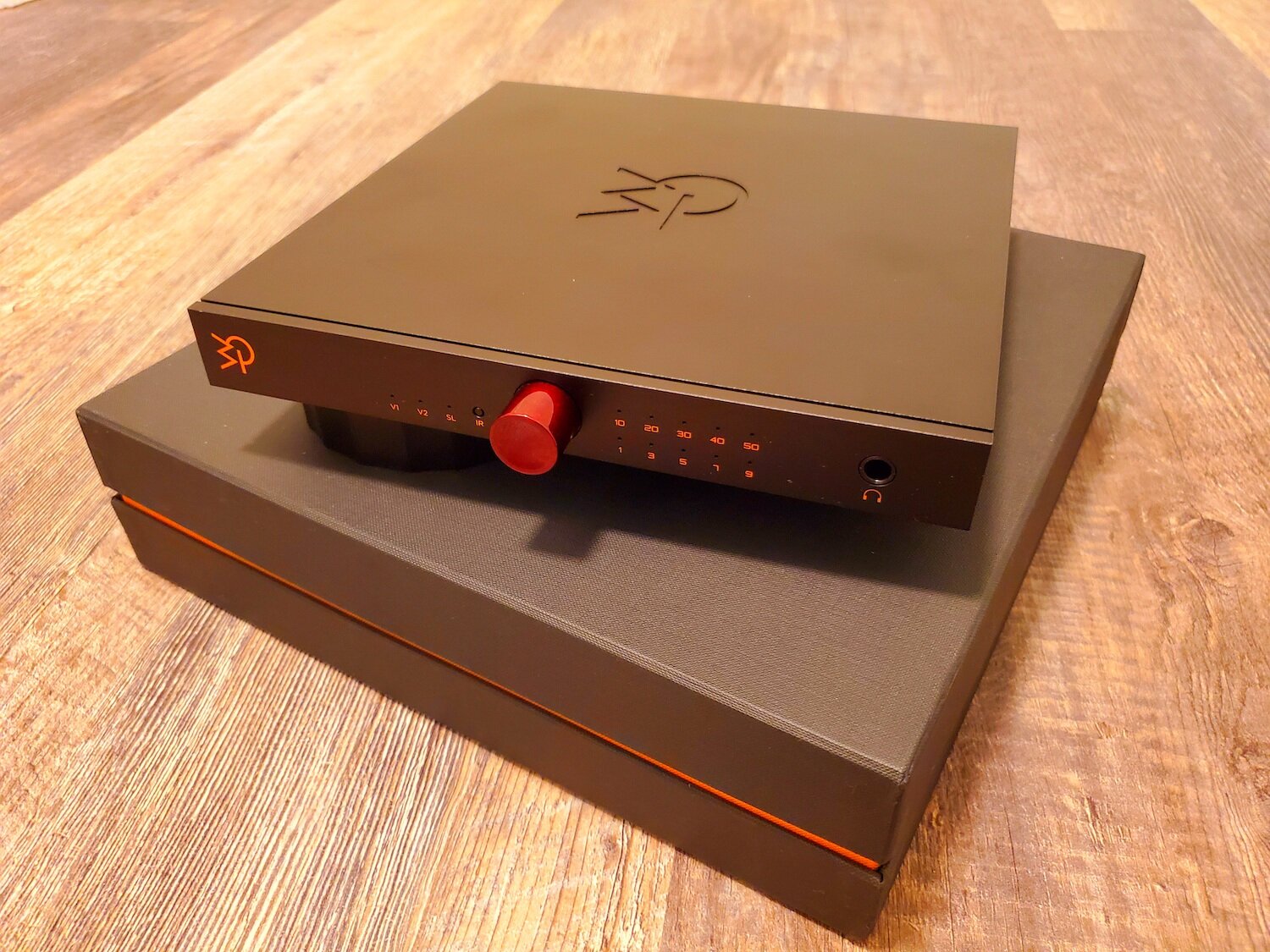OBRAVO RA-C-CU (IEM) REVIEW
The Most Expensive IEM in the World and a Masterstroke of Design Engineering!
This is my second dance with an oBravo product. The first was with the oBravo EAMT-2C ($2,999) which was absolutely stunning and was the first IEM to win our HIGH NINES AWARD. To date, it has been by far my favorite and my reference by which to measure all other IEMs. However, I have now had the opportunity to review a sibling, its big brother—the oBravo RA-C-CU ($10,000). And the RA-C-CU has raised the bar in what might be described as a quantum level leap in overall performance. That said, the RA-C-CU has needs. Well, we all do. Its needs, however, are very specific and should they not be met, that quantum-state potential will never be realized. Ever not met the clearly-stated needs of a significant other? How did that workout?
The RA-C-CU in this way is not unlike a great supercar—Bugatti Chiron, Ferrari 488 Pista, Koenigsegg Jesko, Lamborghini Veneno—that also has its needs. I imagine a supercar’s needs being—a great high-octane fuel, a climate controlled home (garage), never to be driven on backroads or to go four-wheeling or to be driven to the grocery store (daily), its own personal automotive engineer, checkups, and cleanings, so as to be forever shiny. Finicky? Well, if you’re spending the money required to own one of these supercars, I imagine, you’d be well aware of its needs.
The RA-C-CU’s first need—is to be burned-in (driven) for no less than 200 hours (and most possibly 300 hours!). Apparently that patented, miniaturized, AMT II driver (see below) needs to expand and contract a few thousand times or so. The RA-C-CU will also need good, abundant power (super fuel) to be driven, as its specifications—93dB sensitivity, 182 Ohms—demand this. This will rule out smartphones, USB/DAC dongles, most Digital Audio Players (DAPs), and also portable amplifiers that are unable to deliver 1 watt or more to the RA-C-CU. The source will also need to be of “supercar” status. Would a Volkswagen engine in a Lamborghini Veneno make sense? And, importantly, it will need the appropriate eartips necessary to provide an exacting seal for its wearer (driver). Finicky? Well, if you’re spending the money required to own the most expensive IEM on the planet, then I imagine you will also want to be aware of its needs.
The RA-C-CU unlike its sibling the oBravo EAMT-2C will not be jaw dropping at first listen. It will eventually get there and go well beyond, given that its needs are dutifully met. And that these two IEMs have been able to deliver such phenomenal musicality and transparency and engagement, provides easy confirmation, that their design, which utilizes AMT/NDD driver hybridization (referenced below), does, indeed, represent a masterstroke of design engineering for oBravo’s engineers.
REFRAIN: Unlike most reviews, this review will be non-sequential, as it will start, below, with how the equipment actually sounds and not the process of physically “undressing” it and/or laying out its various parts, specifications, etc. Think of this review then, as a non-linear movie—Memento, Kill Bill, Arrival, Eternal Sunshine of the Spotless Mind, The Terminator, In the Shadow of the Moon, The Queen’s Gambit, etc—that, likewise, starts at the end and winds its way to the beginning.
The Sound
Burn-in… Three hundred hours of burn-in later and paired with the Mola Mola Tambaqui and the LTA Z10E (both supercars in their own domains), the RA-C-CU sang sublimely, otherworldly and, especially so, for an IEM! This was, indeed, a quantum level improvement over its EAMT-2C sibling, as well it should be given the price differential.
The oBravo RA-C-CU like the EAMT-2C moved mountains of air, brought spectacular tone/timbre, texture, and a transparency on par with electrostatic headphones, while also managing to take possession of the Holy-Bass-Head-Grail much like planar magnetic headphones. Which begs the question, why don’t more IEM manufacturers use Neodymium Dynamic Drivers (NDD)? The miniaturized AMT drivers I get, they’re patented.
The magic begins, however, when the RA-C-CU’s musicality shows up and saunters in all “analog-like” and brings the house down. Wow! However, understand, like any super, high-end product—sports car, utility, audio component—it has its needs and should they not be met, well, the true potential will never be realized. And I cannot state this enough.
The Obravo RA-C-CU’s volumetric cube—its soundstage—is cavernous in the extreme, wide, deep, with incredible headroom, and it is a soundstage that is effortlessly and naturally constructed and yet wonderfully intimate when called for. The positioning, the layering, the separation, and the macrodynamic cues, are superb and truly reminiscent of a good planar magnetic headphone with a dollop of electrostatic thrown in for good measure.
The oBravo RA-C-CU was paired with the BAKOON AMP-13R, which despite its 22db of gain (158mW), when paired to the Border Patrol SE-i DAC, and MacBook Pro or the Shanling M8 as transport, proved more than sufficient to drive the RA-C-CU. Cabling—USB, interconnects, power cords—was Cardas Clear, and the power conditioner the TORUS TOT MAX.
Bass
Eiji Oue’s Stravinsky rolls on from beginning to end, as I do not even attempt to stop so engaging, so revealing, and provocative the rendering of oBravo’s RA-C-CU as allied to the Bakoon AMP-13R and the Border Patrol SE-i DAC. Notes rise from such a black-quiet background that one is provided with a sense of anticipation, not unlike a good suspense movie. Bass rumble is thunderous, taunt, transient quick, with oceans of detail, and macrodynamic cues that give rise to positioning and differentiation of pitch. Dave Holland’s Emerald Tears, via the combination, plays now with veils removed and a skin-to-bone transparency and lightening-fast transients that fill the oBravo RA-C-CU with the rich textures of bass strings, the reverberant twang and decay of higher pitched bass notes. And all are naturally and musically rendered. I have not heard its like, to date, across this region in an IEM (and I have tried them in this setup)!
Midrange
Kandace Spring’s I Put A Spell On You (The Women Who Raised Me, Bluenote) plays and a piano sounds, setting the stage for Kandace’s voice which enters beautifully and conjures the ethereal in a setting rich with detail and macrodynamic cues. I Can’t Make You Love Me now plays and Kandace’s rich, textured voice banters with the piano as the oBravo RA-C-CU and its compatriots—Bakoon AMP-13R and Border Patrol SE-i DAC—render an incredibly transparent, natural, and engaging performance. Gentle Rain now flows and the stage is intimate, the piano substantive, weighty, natural, and Kandace, center stage, serenades—her voice soulful, intimate, with word and phrase beautifully articulated. This kind of next level performance does not happen everyday, week, month, quarter, year, etc. The oBravo RA-C-CU’s its needs beautifully met via the Bakoon AMP-13R and the Border Patrol SE-i DAC is providing for an absolutely next-level musical experience, which, to date, no Balanced Armature (BA) design nor dynamic IEM has been able to replicate. While this fact was certainly made true by the oBravo EAMT-2C, the message has now been memorialized by the oBravo RA-C-CU and its hybridization model. Even the implementation of Electrostatic drivers in IEMs does not come close to delivering the kind of naturalness and speed of the miniaturized AMT driver, as I’ve heard quite a few of those implementations. Normally, I would have stopped here so compellingly rendered was the music. However, I could not. Olafur Arnalds’ Árbakkinn (Island Songs, Mercury (Universal France)) plays and the quiet ease, the shoulder-lowering naturalness is all too reminiscent of vinyl. And as the strings reach to great treble heights the oBravo RA-C-CU renders a sibilance, harshness, and stridency free experience, that is natural and transparent and alive. It is one of the most engaging, most information-rich listens from an IEM in my experience, to date.
Treble+
One of my test tracks for how well a piece of equipment can manage a sibilance heavy track(s) is Patricia Barber’s Nightclub album (Nightclub, Premonition Records). How well will the RA-C-CU’s AMT driver handle this test? Bye Bye Blackbird plays and as Patricia’s voice enters and moves from verse to verse, the music is resolved beautifully, naturally without the slightest insinuation of sibilance or stridency or harshness. Hi-Hats, cymbals—splash, ride, crash—and brushes over them are all well and naturally resolved. The AMT driver is lightening fast and moves tremendous amounts of air, no doubt, helpful in the resolution of high frequency detail, its extension, and the associated macrodynamic cues, while leaving all negative artifacts in permanent exile. The oBravo RA-C-CU delivers an air-filled spaciousness, that is rich, natural, layered across the entirety of this album. And like its less costly sibling—EAMT-2C—the oBravo RA-C-CU, truly, delivers an “emotionally breathtaking” performance across the treble.
The Wrappings and Accessories
Round two for design and the take-home-carton-like outermost box is still in play. When I inquired as to why such an “interesting” box for an expensive IEM, during the EAMT-2C review, oBravo’s David Teng stated:
“We designed the package in consideration of being environmentally friendly, as we are a small company, that seeks to do our part to reduce carbon emissions. The package is part of our strategy and will remain in place for the foreseeable future.”
And I understood, but also thought, bamboo is cheap and, for all intents and purposes, it’s a weed, isn’t it? The frustrated designer in me simply had to throw that in. Who knows?
However, when the take-home-carton-like outer box is opened (and recycled) the design parade truly begins. One finds the beautifully designed RA-C-CU in its Acacia wood, copper, and ceramic suit, above a 6.35mm single-ended adapter. Additionally, there are two Acacia wood boxes, one large, beautifully lacquered display box and a smaller natural wood travel box. Both are quite beautiful and each has a bed for the RA-C-CU and basement level storage for cable, tips, etc. The smaller box will not fit in one’s pocket, but it will fit in backpacks, briefcases, and most purses, though not those of the cocktail variety. The other accessories are:
1 black housing, gold plated jack, 2.5mm to 3.5mm adapter
1 black housing, gold plated jack, 2.5mm to 4.4mm adapter
3 sets of Comply foam tips (small, medium, large)
3 sets of silicone tips (small, medium, large)
And finally, there is a 1.2m white, braided MMCX cable terminated with a 2.5mm gold-plated jack.
In the end, once the outermost box is recycled, the beautifully finished inner boxes, the RA-C-CU, and the included accessories can be said to more closely align with its super IEM price point, as it and they are quite gorgeous.
Design—Look and Feel and Fit
Like the EAMT-2C the RA-C-CU is beautifully wrapped in a mix of materials—Acacia wood, copper and a ceramic shell. The Acacia wood forms the RA-C-CU’s back cavity, the copper its outer housing, and the ceramic shell its front cavity. Why these materials? As oBravo explains:
Thermo-modified acacia wood
We carefully select the wood of acacia confusa grown natively in Taitung county processed with thermo-modification, thus producing a unique material whose superb acoustic quality is recognized even by the Spanish guitar master artisan Mr. Adolfo Timuat Toyoda.
Advanced ceramics
For the structure of our earphones, we use the advanced ceramics kiln-fired at a temperature of over 1800 °C, which can convey every detail of the high notes, rendering their sound resounding and crystal clear.
Taylormade metal structure
Aluminum/Titanium/copper: as each of them produces its own distinctive sound when made into earphones (and thus allows for a particular running based upon the selection of metal chosen for one’s custom IEM).
Again, the various materials come together beautifully to form a rather exquisite and luxurious enclosure and, as noted above, the resultant materials synergy produces a sound that is unprecedented in my IEM listening experience and a quantum level improvement over the EAMT-2C (its needs met)!
Technology. The Obravo RA-C-CU employs dual technologies—an upgraded version of the 8mm Air Motion Transformer (AMT)—the 8mm AMT II—as its tweeter and a larger 16mm Neodymium Dynamic Driver for mid/bass frequencies—in a hybridized fashion.
As mentioned in the EAMT-2C review, the AMT technology was invented by Dr. Oskar Heil (1908–1994) and had a patent (US3636278A) issued January 18, 1972. The AMT technology employs a bellows-like, pleated diaphragm that:
“Moves air laterally in a perpendicular motion using a metal-etched folded sheet made of polyethylene terephthalate (PET) film…
The result is a dipole driver with an extraordinarily rapid response rate, enabled by the extremely low mass of the polyethylene substrate and the far smaller distance it travels on each "swing" compared to a dynamic driver…
The discernible motion of each diaphragm flexure is very small, but because of the folded structure, more air is moved than would be by a conventional cone or electrostatic driver of the same plotted surface area.”
The main differences between the RA-C-CU and the EAMT-2C are as David Teng of oBravo informs me:
The RA-C-CU’s 2nd generation, AMT-8II, 8mm, driver improves the sound and increases the overall output by approximately 8 to 10dB, in order to better match the larger 16mm NDD driver.
The RA-C-CU’s 16mm NDD driver is much larger than the EAMT-2C’s 12mm NDD driver, which allows it to generate more detail, weight, and more of a feeling of “aliveness.”
The RA-C-CU’s new copper housing also helps to generate a more solid and stable bass without impacting the treble.
And the RA-C-CU’s revised internal air flow aids in the generation of a deep, clean sub-bass.
The larger Neodymium Dynamic Driver (NDD) used for the oBravo RA-C-CU coupled with the upgraded 8mm AMT II tweeter provide a sound profile, that in some sense may be considered revolutionary. It has certainly made me aware of this rather unique hybridization and what it does, in particular, for IEMs. I have heard this combination in speakers—floor standing and monitor—and in headphones, but never before in an IEM and never before have they worked this well together.
The Specifications
oBravo RA-C-CU
Back Cavity:Acacia Wood
Outer Housing:Aluminum Alloy
Front Cavity:Advanced Ceramics
Frequency Response: 10Hz~45KHz
Tweeter: 8mm Air Motion Transformer II Tweeter
Dynamic Driver: 16mm Neodymium Driver
Impedance: 182 ohm
Sensitivity: 93dB
Drivability
As mentioned above, the Obravo RA-C-CU, due to their medium to high impedance (182 Ω -Ohms) and their low to middling sensitivity (93dB), will not be the easiest IEMs to drive. And for optimum performance only powerful DAPs, DAC/Amplifiers, and desktop solutions are very highly recommended, if not required. The best way to understand the RA-C-Cu is that it is an IEM whose power needs are comparable to those of a medium-efficiency, high impedance, planar magnetic headphone. Awareness of this will find the RA-C-CU optimized. This is after all a $10,000 IEM, which I would imagine, for most, would stay secured in one’s home, near the desktop headphone amplifier/DAC or some combination thereof.
Comparisons
It came down to four songs that would be utilized to help differentiate between the various IEMs. The comparisons were done using the following four tracks/songs—
Joan Shelly’s “Wild Indifference” (Joan Shelly, No Quarter)
Olafur Arnalds’ “Árbakkinn” (Island Songs, Mercury (Universal France))
Massive Attack’s “Angel” (MEZZANINE, Virgin), and
Eiji Oue’s “The Firebird Suite (1919 version): VII Finale” (Stravinsky, Reference Recordings)
The various IEMs were all partnered to the BORDER PATROL SE-i and the Bakoon AMP-13R via Cardas cabling and TORUS power conditioning.
Vision Ears EVE2020 ($1,300)
The VISION EARS EVE2020 is a beautifully musical, transparent, and extended IEM, that at its price point or, perhaps, even twice that is a game competitor, and will surprise if not embarrass more expensive IEMs. It is not, however, the oBravo RA-C-CU nor should it be at one sixth the cost. The RA-C-CU excels versus the EVE2020 across every parameter, though there is a warmth across the EVE’s midrange via its dynamic driver, that moves it to, at least, competitive with the RA-C-CU and its Neodymium Dynamic Driver.
Vision Ears ELYSIUM ($2500)
Interestingly, in comparison to the oBravo RA-C-CU the VISION EARS ELYSIUM, for several reasons, did not stand up as well as had its sibling the EVE2020. There was no contest in terms of bass extension, treble extension, soundstage volume, coherency, transient speed, or overall musicality. While the VISION EARS ELYSIUM is a decidedly good IEM, once the needs were met for the oBravo RA-C-CU there were no aspects between the two IEMs were the oBravo did not excel.
oBravo EAMT-2C ($3,000)
Upon first hearing of the EAMT-2C I was literally gobsmacked. How could an IEM straight out of the box sounds so incredibly good, so exceptional? Apparently, it was the technology and the engineering behind the EAMT-2C—Dynamic Drivers with Neodymium magnets and patented AMT drivers—that distinguished this IEM above all others. That is until its sibling with like but upgraded, next-generation drivers entered the picture. And while these next-generation drivers needed a great deal more time to open up and relax, the result of the oBravo RA-C-CU, in the end, was truly stunning. The oBravo RA-C-CU extends a competitive advantage across all relevant parameters from bass extension to treble extension to transparency to a coherency that holds together through the most complex and dynamic passages to a more expansive soundstage.
Synergy
SHANLING M8 ($1659)
The oBravo RA-C-CU as paired to the Shanling M8, the only DAP truly able to drive these IEMs, was extraordinary! In the review of the Shanling M8 I likened it to a desktop system that was simply masquerading as a DAP, given it power reserves (turbo mode), its transparency, and its, truly, superb musicality. I did not expect the M8 to be as good as it is, but it was certainly a welcome surprise. And in that same review, I likened the oBravo RA-C-CU to an IEM masquerading as a planar magnetic headphone. Given that, this is a combination that will absolutely find its way to our Magical Synergies list, so incredible was the music they made together.
BAKOON AMP-13R/BORDER PATROL DAC ($7775)
While the Shanling M8 was exceptional as paired to the RA-C-CU, the pairing of the Bakoon AMP-13R and the Border Patrol DAC SE-i to the oBravo RA-C-CU brought the experience to an entirely new level across all reviewed parameters—transparency (and thus oceans of detail), lickety-split-stop-on-a-dime, transient speed, foundational weight from top to bottom, sublime musicality, and engagement that made real, tangible, corporeal the various performances. Dave Holland’s Emerald Tears was laid bare, beautifully, via the oBravo RA-C-CU, the Border Patrol SE-i DAC, and the Bakoon AMP-13R. Given the RA-C-CU’s price ($10,000) this would, indeed, represent a real world pairing for the TOTL, super IEM. Together they provided a truly compelling listen, though this can be troublesome for reviewers, as we seek to pick and chose our tracks, and entire albums would pass by, so engaging and magical the listen.
LTA Z10E/MOLA MOLA TAMBAQUI DAC ($18,450)
The words that come immediately to mind as the music plays from this combo to the RA-C-CU are transparency, spaciousness, naturalness of tone/timbre, three dimensional and a decided tube-like ease. The Mola Mola Tambaqui (review coming soon), a truly outstanding DAC, brought all the transparency, air, and space and musicality that one could need. The LTA Z10e brought its own incredible transparency, timbral beauty, transient speed, and a sublime, natural midrange. Together and as allied to the oBravo RA-C-CU the synergy was spectacular, holographic, three-dimensional, and also intimate when required. Price wise this combination would certainly represent a coming home for the oBravo RA-C-CU, a real world marriage, and the most optimal pairing in terms of required powered and general abilities and music making.
Conclusion
The Obravo RA-C-CU is a TOTL IEM not unlike the TOTL super cars—the Bugatti Chiron, Ferrari 488 Pista, Koenigsegg Jesko, Lamborghini Veneno, and Pagani Zonda Revolucion. And when its needs are dutifully met, as outlined above, its owner will be greatly rewarded with next-level musicality, transparency, and engagement.
In terms of other IEMs that I have listened to, to date, the oBravo RA-C-CU has no competitors in this segment. It is as mentioned in the writeup above, an IEM that may well be masquerading as both a planar magnetic headphone with a pinch of an electrostatic headphone thrown in for good measure. Those who have listened to planar and electrostatic headphones will get this pretty quickly. And given that this is my second review of an IEM utilizing an NDD/AMT hybridized model, the secret is definitely in this beautifully engineered “sauce” so to speak. This is not yesteryears’ technology and it represents, in and of itself, that quantum leap in personal hi-fi that is breaking out all over the world and to all of our great benefit. Coupled with the online, music compendiums—Qobuz, Tidal, Spotify, Amazon Music, etc.—perhaps, this represent a golden age in musical playback, when so much else is, decidedly, not.
You must, however, remember the needs of the oBravo RA-C-CU. Of course, the price of admission is substantial in the extreme, however, those able to indulge, like the owners of the super cars listed above, will find incredible, musical enjoyment from which it may be difficult to escape. Perhaps not unlike the goddess CIRCE’s island—Aeaea.
I very highly recommend the oBravo RA-C-CU as the best IEM, to date, far surpassing the talents of its EAMT-2C sibling, though it will not wow straight out of the box, as does the EAMT-2C. You must, however, remember the needs of the oBravo RA-C-CU and exercise a wee bit of patience, during its 200-300 hours of burn-in. We, Audiokey Reviews, happily award the oBravo RA-C-CU our DIAMOND award, our highest, for its magnificent musicality, transparency, engagement, its top-to-bottom extension, its wood, copper, and ceramic materials design, brilliant engineering, and its transcendence of the IEM category altogether. The oBravo RA-C-CU is more than just an IEM (see planar headphone, electrostatic headphone).
Pros: Top to bottom extension, transparency, musicality, transient speed, next-level performance.
Cons: It has needs that must be met.
THE system(S)
1.
LTA Z10e
Mola Mola Tambaqui
MacBook Pro/Shanling M8 (as transport)
Cardas Cables
Torus Power TOT MAX
2.
Bakoon AMP-13R
Border Patrol DAC
MacBook Pro/Shanling M8 (as transport)
Cardas Cables
Torus Power TOT MAX
THE COMPANY
Obravo
Obravo RA-C-CU $10,000
Obravo
Stymax International Co., LTD.
4F., No. 495, Guangfu S. Rd., Xinyi Dist.
Taipei City 11074, Taiwan R.O.C.












